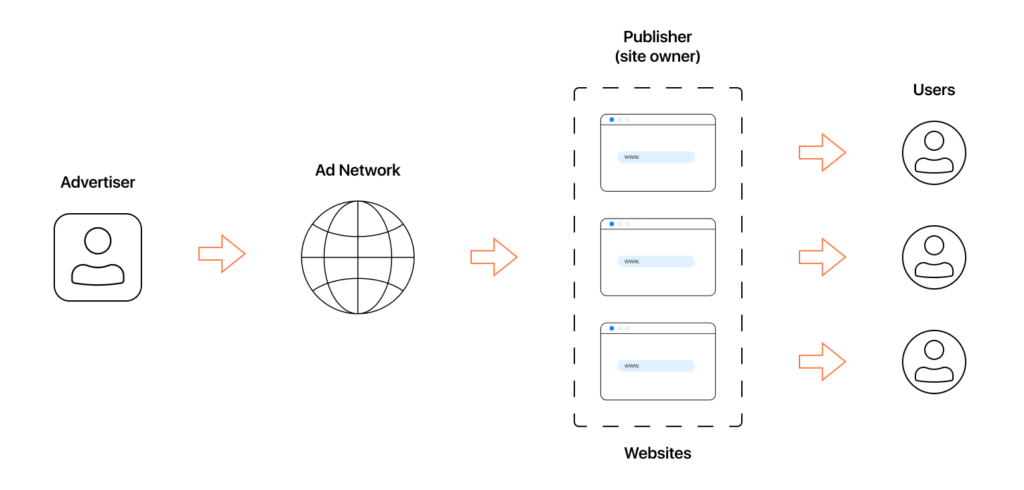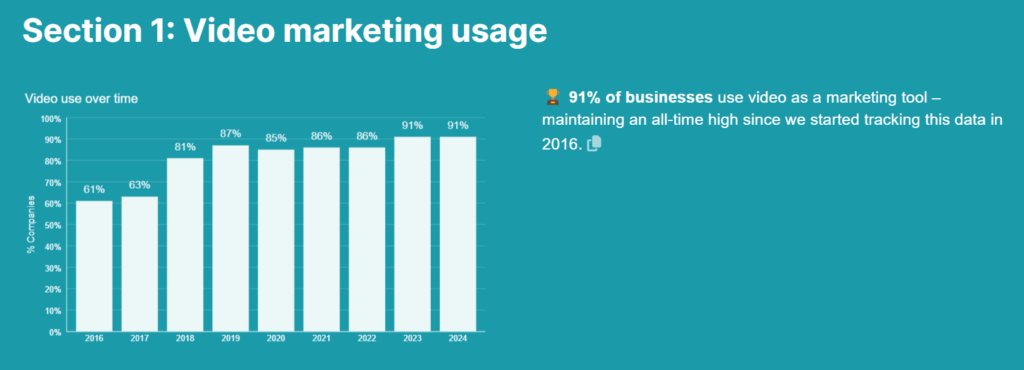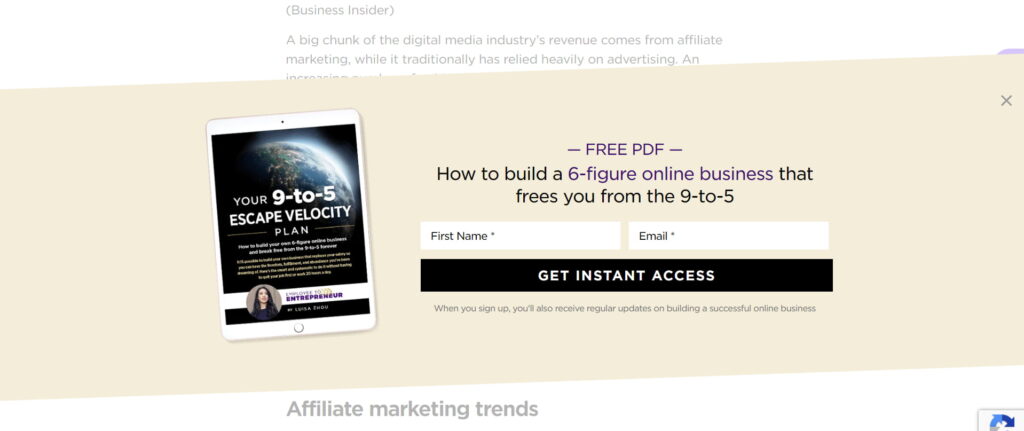Blog

Affiliate marketing can seem an easy way to earn money, but the enthusiasm is waning when it comes to running a website. This idea is always associated with long-term work, while the majority long to make money right here and now. Fortunately, owning a website to benefit from affiliate marketing is a huge bias.
The world of affiliate marketing is vast, offering multiple avenues for aspiring marketers to make a profit without the hassle of maintaining a website. In this article, we’ll talk about how you can dive right in, leveraging alternative strategies to start earning.
In today’s digital era, the avenues for affiliate marketing have expanded beyond websites. Marketers now leverage various platforms to reach their target audience directly. Social media, email marketing, ad networks, and video-sharing sites like YouTube offer dynamic and interactive ways to promote products without needing a website. These platforms allow for direct engagement with your audience, enabling you to recommend products in a more personal and relatable manner.
As affiliate marketers explore these direct channels, the question arises: How can one effectively lead an audience to take action without the traditional structure of a website? This is where the concept of landing pages and pre-landings comes into play, offering a seamless transition from general promotion to focused action.
Landing pages are the bridge between your promotional content on social media, emails, or video platforms and the affiliate products you recommend. Unlike a broad website that may contain diverse content, a landing page is singularly focused and designed with one goal in mind: to convert visitors into actions that are trackable and directly tied to your affiliate marketing objectives, such as making a purchase or signing up for a newsletter.
While landing pages are designed to convert, pre-landing pages serve as an essential preliminary step in this process, preparing and warming up visitors for what’s to come. Pre-landing pages are crafted to engage and educate potential customers before directing them to the main landing page where the conversion action takes place. Think of a pre-landing page as the storyteller that sets the scene and builds anticipation.
Examples of pre-landing and landing pages:





By effectively utilizing both a pre-landing and a landing page, marketers can create a more engaging, informative, and persuasive pathway that leads to higher conversion rates and better campaign performance.
Embarking on an affiliate marketing journey doesn’t necessarily require a website. By taking the right approach, you can tap into the power of CPA networks and affiliate programs to start earning commissions by promoting products or services.
Here’s a simple guide to get you started on this path.
The first step is to sign up with a CPA (Cost Per Action) network or an affiliate program. These platforms act as intermediaries between affiliates and merchants, offering access to a wide array of offers from various brands under one roof. The best part, you can use CPA networks and affiliate programs without a website.
The biggest affiliate network is Amazon Associates, as per the 2023 Influence Marketing Hub report. If you are just starting, test CPA networks for beginners featured in the AllPushNetworks blog article.
Once you’ve joined a CPA network or affiliate program, choose an offer to promote. The success of your affiliate marketing efforts largely depends on the quality of the offer you select. Look for offers that are fresh and not saturated in the market. It’s important to consider the offer’s relevance to your target audience, its demand, and payout. Testing various offers and analyzing their performance is key to identifying the most profitable ones.
Understanding the offer’s requirements and constraints is crucial. This includes:
An example of requirements to offer promotion at MyLead, a sought-after affiliate network:
Keep in mind, that a compelling, well-timed offer that meets the needs and interests of your target audience can dramatically increase the chances of successful conversions.
Your promotional activities can begin once you have an offer in hand. There are numerous ways to promote affiliate offers without a website, but one of the easiest and most effective methods is through advertising networks. These networks provide access to a vast base of publishers (website owners, bloggers and other digital content creators) who already have the traffic you can tap into.
In the next section, we will discuss how to promote affiliate products to make money.
There are myriad ways to generate income without owning a website. These methods range from straightforward to more intricate, each offering unique advantages and challenges. Today, we’ll explore these strategies, starting with the most accessible approach – using ad networks – to more complex tactics like leveraging YouTube and social media platforms.
While building an audience on platforms like YouTube and social media may seem daunting, it’s still simpler than managing a website. Here’s why: platforms like YouTube simplify content creation and distribution, removing the technical barriers associated with website development and maintenance.
Now, let’s dive into these methods, beginning with the simplest strategy.
Advertising networks represent the most straightforward entry point into affiliate marketing. These platforms bridge the gap between advertisers and publishers, providing a plethora of advertising formats to suit various campaign needs.
Here’s how they work and their benefits.
Advertising networks connect affiliate marketers (advertisers) with potential ad spaces (publishers). As an affiliate marketer, you can select from a wide range of ad formats and target your ads to reach the right audience at the right time. The process involves selecting the ad format, setting up your campaign, and monitoring its performance for optimizations.

An explanation of how ads work in a graphic
Advantages of using advertising networks:
Certain verticals perform exceptionally well within advertising networks, including but not limited to health and wellness, finance, dating, and e-commerce. These sectors offer high engagement and conversion potential due to their broad appeal and consumer interest.
Google Ads emerges as a sophisticated and effective strategy for affiliate marketers seeking to attract targeted traffic without owning a website. This platform leverages the power of search intent, connecting products and services with individuals actively seeking solutions. Unlike SEO, which requires time to yield results, Google Ads offers immediate visibility at the top of search engine results pages (SERPs), providing a swift influx of potential traffic to your affiliate offers.
Users who search on Google typically have a specific intent, whether it’s to find information, compare products, or make a purchase. By targeting specific keywords related to your affiliate products, you can tap into this high-intent traffic.
Social media isn’t just for sharing memes and catching up with friends anymore. Platforms like Instagram, Facebook, TikTok can be your playground for affiliate marketing. Create content that resonates with your audience, integrate your affiliate links naturally, and watch as your followers engage with your recommended products or services. Be authentic and consistent; the key is to build trust with your audience.
While social media allows for creative and authentic engagement with your audience, it’s important to be mindful of platform-specific restrictions, especially concerning certain verticals like adult content or gambling, which can quickly lead to bans.
YouTube is a powerful platform for affiliate marketers. Start a channel around a specific niche, offer valuable content, and include affiliate links in your video descriptions. Reviews, tutorials, and how-to videos work exceptionally well for affiliate marketing. Make sure your videos are engaging and informative to keep your audience coming back for more.

Be aware that video production can incur costs, from equipment to editing software, but the platform’s wide reach and engagement potential can offer substantial returns.
Build an email list by offering something valuable in exchange for email addresses. Think of eBooks, webinars, or exclusive insights related to your niche. This method is best suited if you’re willing to invest time in creating and sharing valuable content. It requires a commitment to content creation and a strategy to build and maintain an email list. Once you have a list, you can start sending out affiliate offers directly to your subscribers. Remember, personalization and providing value are crucial here; nobody likes spammy emails.
Join online communities and forums related to your niche. Platforms like Reddit, Quora, and niche-specific forums are great places to share your expertise and affiliate links, as long as you follow the community rules and contribute value. Being helpful and establishing yourself as an authority can go a long way in building trust and driving affiliate sales.
According to Matter findings, 69% of consumers trust recommendations from influencers. By partnering with influencers, you can tap into their audience to promote your affiliate products. Ensure it’s a win-win situation by offering value to the blogger and their audience. To be effective, influencer partnerships must provide value to all parties involved – the brand, their audience, and you. This often requires careful negotiation and alignment of goals.
Here’s how you can leverage the power of digital tools and platforms to maximize your visibility and effectiveness as an affiliate marketer.
Lead magnets are your first step towards attracting potential customers without a website. Create engaging, valuable content that solves a specific problem or answers a question for your target audience.

Here are some creative ideas for lead magnets that can help you capture leads:
When designing your lead magnet, ensure it’s directly relevant to both your affiliate products and the interests of your target audience. Use design tools like Canva for visually appealing creations, and host your lead magnet on accessible platforms where users can easily download or access them after providing their email addresses.
You shouldn’t limit yourself to just one platform. Diversify your presence across multiple content platforms to enhance your visibility:
SEO isn’t just for website owners. Utilize SEO tools like Google Keyword Planner, Ahrefs, or SEMrush to uncover keywords your target audience is searching for. Incorporate these keywords into your content on YouTube, Medium, LinkedIn, and even in the descriptions of your social media posts. This will enhance the discoverability of your content, making it more likely to be seen by interested users.
Trackers are indispensable in the world of affiliate marketing, providing you with actionable insights into your campaign’s performance. Utilize tracking solutions like Voluum or Keitaro to monitor where your traffic is coming from, which of your strategies are converting, and where there’s room for optimization. These tools offer clarity on the performance of your lead magnets and the success of your CPC ad campaigns, enabling you to invest more wisely in strategies that work.
Focus on topics closely related to your affiliate products. For example, if you’re promoting nutra supplements, you could start a podcast on wellness and nutrition. Bring on guests who can offer valuable insights into your niche, adding credibility and variety to your content. You can use episodes to discuss and review affiliate products, ensuring to include your affiliate links in the show notes.
To reach a wider audience, promote your podcast across your social media channels, and consider podcast-specific platforms like Spotify and Apple Podcasts.
The essence of affiliate marketing without a website is flexibility and creativity. It’s about finding innovative ways to connect with your audience, provide value, and drive conversions. As you embark on or continue your pursuit of affiliate marketing, keep experimenting with different strategies, track your results, and optimize your campaigns based on performance data. This iterative process will help you discover what works best for your niche and audience, allowing you to maximize your affiliate marketing success without the need for a traditional website.
Affiliate marketing can seem an easy way to earn money, but the enthusiasm is waning when it comes to running a website. This idea is always associated with long-term work, while the majority long to make money right here and now. Fortunately, owning a website to benefit from affiliate marketing is a huge bias.
The world of affiliate marketing is vast, offering multiple avenues for aspiring marketers to make a profit without the hassle of maintaining a website. In this article, we’ll talk about how you can dive right in, leveraging alternative strategies to start earning.
In today’s digital era, the avenues for affiliate marketing have expanded beyond websites. Marketers now leverage various platforms to reach their target audience directly. Social media, email marketing, ad networks, and video-sharing sites like YouTube offer dynamic and interactive ways to promote products without needing a website. These platforms allow for direct engagement with your audience, enabling you to recommend products in a more personal and relatable manner.
As affiliate marketers explore these direct channels, the question arises: How can one effectively lead an audience to take action without the traditional structure of a website? This is where the concept of landing pages and pre-landings comes into play, offering a seamless transition from general promotion to focused action.
Landing pages are the bridge between your promotional content on social media, emails, or video platforms and the affiliate products you recommend. Unlike a broad website that may contain diverse content, a landing page is singularly focused and designed with one goal in mind: to convert visitors into actions that are trackable and directly tied to your affiliate marketing objectives, such as making a purchase or signing up for a newsletter.
While landing pages are designed to convert, pre-landing pages serve as an essential preliminary step in this process, preparing and warming up visitors for what’s to come. Pre-landing pages are crafted to engage and educate potential customers before directing them to the main landing page where the conversion action takes place. Think of a pre-landing page as the storyteller that sets the scene and builds anticipation.
Examples of pre-landing and landing pages:





By effectively utilizing both a pre-landing and a landing page, marketers can create a more engaging, informative, and persuasive pathway that leads to higher conversion rates and better campaign performance.
Embarking on an affiliate marketing journey doesn’t necessarily require a website. By taking the right approach, you can tap into the power of CPA networks and affiliate programs to start earning commissions by promoting products or services.
Here’s a simple guide to get you started on this path.
The first step is to sign up with a CPA (Cost Per Action) network or an affiliate program. These platforms act as intermediaries between affiliates and merchants, offering access to a wide array of offers from various brands under one roof. The best part, you can use CPA networks and affiliate programs without a website.
The biggest affiliate network is Amazon Associates, as per the 2023 Influence Marketing Hub report. If you are just starting, test CPA networks for beginners featured in the AllPushNetworks blog article.
Once you’ve joined a CPA network or affiliate program, choose an offer to promote. The success of your affiliate marketing efforts largely depends on the quality of the offer you select. Look for offers that are fresh and not saturated in the market. It’s important to consider the offer’s relevance to your target audience, its demand, and payout. Testing various offers and analyzing their performance is key to identifying the most profitable ones.
Understanding the offer’s requirements and constraints is crucial. This includes:
An example of requirements to offer promotion at MyLead, a sought-after affiliate network:
Keep in mind, that a compelling, well-timed offer that meets the needs and interests of your target audience can dramatically increase the chances of successful conversions.
Your promotional activities can begin once you have an offer in hand. There are numerous ways to promote affiliate offers without a website, but one of the easiest and most effective methods is through advertising networks. These networks provide access to a vast base of publishers (website owners, bloggers and other digital content creators) who already have the traffic you can tap into.
In the next section, we will discuss how to promote affiliate products to make money.
There are myriad ways to generate income without owning a website. These methods range from straightforward to more intricate, each offering unique advantages and challenges. Today, we’ll explore these strategies, starting with the most accessible approach – using ad networks – to more complex tactics like leveraging YouTube and social media platforms.
While building an audience on platforms like YouTube and social media may seem daunting, it’s still simpler than managing a website. Here’s why: platforms like YouTube simplify content creation and distribution, removing the technical barriers associated with website development and maintenance.
Now, let’s dive into these methods, beginning with the simplest strategy.
Advertising networks represent the most straightforward entry point into affiliate marketing. These platforms bridge the gap between advertisers and publishers, providing a plethora of advertising formats to suit various campaign needs.
Here’s how they work and their benefits.
Advertising networks connect affiliate marketers (advertisers) with potential ad spaces (publishers). As an affiliate marketer, you can select from a wide range of ad formats and target your ads to reach the right audience at the right time. The process involves selecting the ad format, setting up your campaign, and monitoring its performance for optimizations.

An explanation of how ads work in a graphic
Advantages of using advertising networks:
Certain verticals perform exceptionally well within advertising networks, including but not limited to health and wellness, finance, dating, and e-commerce. These sectors offer high engagement and conversion potential due to their broad appeal and consumer interest.
Google Ads emerges as a sophisticated and effective strategy for affiliate marketers seeking to attract targeted traffic without owning a website. This platform leverages the power of search intent, connecting products and services with individuals actively seeking solutions. Unlike SEO, which requires time to yield results, Google Ads offers immediate visibility at the top of search engine results pages (SERPs), providing a swift influx of potential traffic to your affiliate offers.
Users who search on Google typically have a specific intent, whether it’s to find information, compare products, or make a purchase. By targeting specific keywords related to your affiliate products, you can tap into this high-intent traffic.
Social media isn’t just for sharing memes and catching up with friends anymore. Platforms like Instagram, Facebook, TikTok can be your playground for affiliate marketing. Create content that resonates with your audience, integrate your affiliate links naturally, and watch as your followers engage with your recommended products or services. Be authentic and consistent; the key is to build trust with your audience.
While social media allows for creative and authentic engagement with your audience, it’s important to be mindful of platform-specific restrictions, especially concerning certain verticals like adult content or gambling, which can quickly lead to bans.
YouTube is a powerful platform for affiliate marketers. Start a channel around a specific niche, offer valuable content, and include affiliate links in your video descriptions. Reviews, tutorials, and how-to videos work exceptionally well for affiliate marketing. Make sure your videos are engaging and informative to keep your audience coming back for more.

Be aware that video production can incur costs, from equipment to editing software, but the platform’s wide reach and engagement potential can offer substantial returns.
Build an email list by offering something valuable in exchange for email addresses. Think of eBooks, webinars, or exclusive insights related to your niche. This method is best suited if you’re willing to invest time in creating and sharing valuable content. It requires a commitment to content creation and a strategy to build and maintain an email list. Once you have a list, you can start sending out affiliate offers directly to your subscribers. Remember, personalization and providing value are crucial here; nobody likes spammy emails.
Join online communities and forums related to your niche. Platforms like Reddit, Quora, and niche-specific forums are great places to share your expertise and affiliate links, as long as you follow the community rules and contribute value. Being helpful and establishing yourself as an authority can go a long way in building trust and driving affiliate sales.
According to Matter findings, 69% of consumers trust recommendations from influencers. By partnering with influencers, you can tap into their audience to promote your affiliate products. Ensure it’s a win-win situation by offering value to the blogger and their audience. To be effective, influencer partnerships must provide value to all parties involved – the brand, their audience, and you. This often requires careful negotiation and alignment of goals.
Here’s how you can leverage the power of digital tools and platforms to maximize your visibility and effectiveness as an affiliate marketer.
Lead magnets are your first step towards attracting potential customers without a website. Create engaging, valuable content that solves a specific problem or answers a question for your target audience.

Here are some creative ideas for lead magnets that can help you capture leads:
When designing your lead magnet, ensure it’s directly relevant to both your affiliate products and the interests of your target audience. Use design tools like Canva for visually appealing creations, and host your lead magnet on accessible platforms where users can easily download or access them after providing their email addresses.
You shouldn’t limit yourself to just one platform. Diversify your presence across multiple content platforms to enhance your visibility:
SEO isn’t just for website owners. Utilize SEO tools like Google Keyword Planner, Ahrefs, or SEMrush to uncover keywords your target audience is searching for. Incorporate these keywords into your content on YouTube, Medium, LinkedIn, and even in the descriptions of your social media posts. This will enhance the discoverability of your content, making it more likely to be seen by interested users.
Trackers are indispensable in the world of affiliate marketing, providing you with actionable insights into your campaign’s performance. Utilize tracking solutions like Voluum or Keitaro to monitor where your traffic is coming from, which of your strategies are converting, and where there’s room for optimization. These tools offer clarity on the performance of your lead magnets and the success of your CPC ad campaigns, enabling you to invest more wisely in strategies that work.
Focus on topics closely related to your affiliate products. For example, if you’re promoting nutra supplements, you could start a podcast on wellness and nutrition. Bring on guests who can offer valuable insights into your niche, adding credibility and variety to your content. You can use episodes to discuss and review affiliate products, ensuring to include your affiliate links in the show notes.
To reach a wider audience, promote your podcast across your social media channels, and consider podcast-specific platforms like Spotify and Apple Podcasts.
The essence of affiliate marketing without a website is flexibility and creativity. It’s about finding innovative ways to connect with your audience, provide value, and drive conversions. As you embark on or continue your pursuit of affiliate marketing, keep experimenting with different strategies, track your results, and optimize your campaigns based on performance data. This iterative process will help you discover what works best for your niche and audience, allowing you to maximize your affiliate marketing success without the need for a traditional website.

Blog

Blog